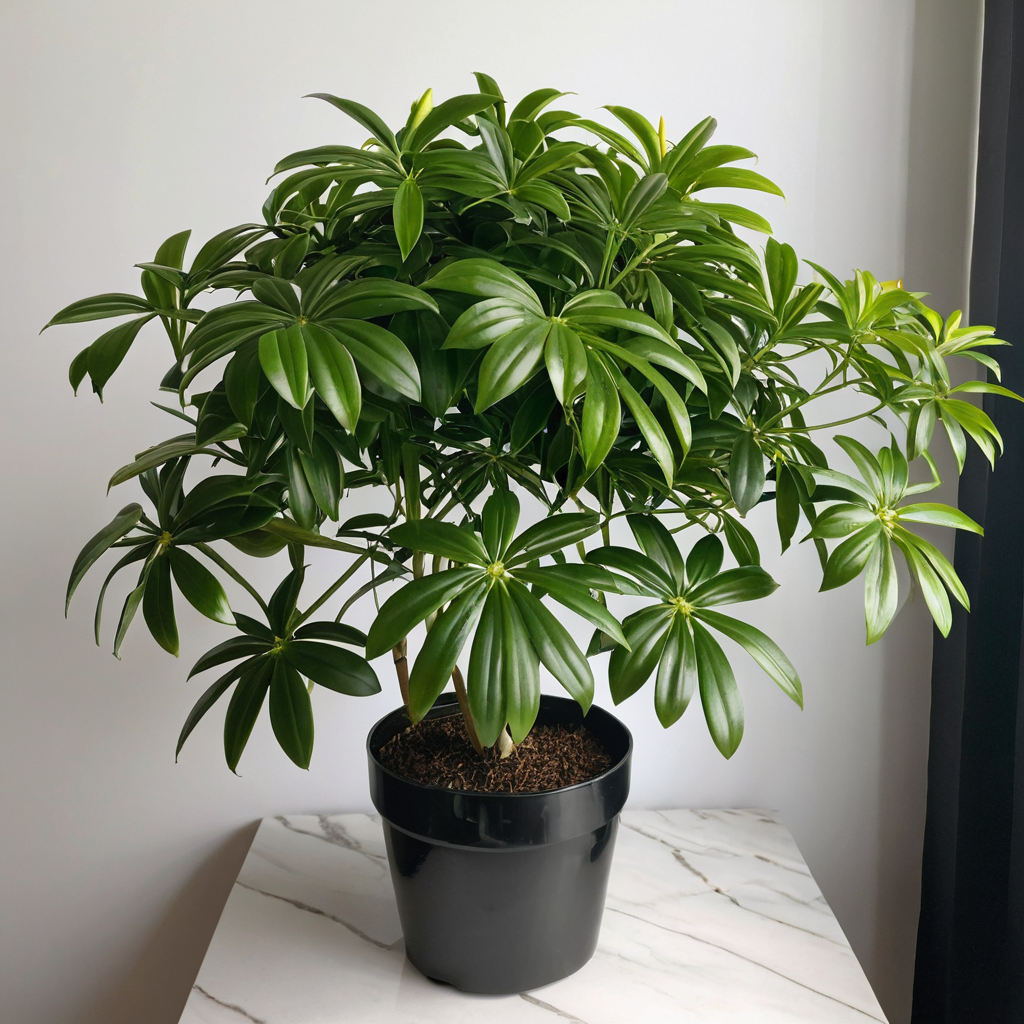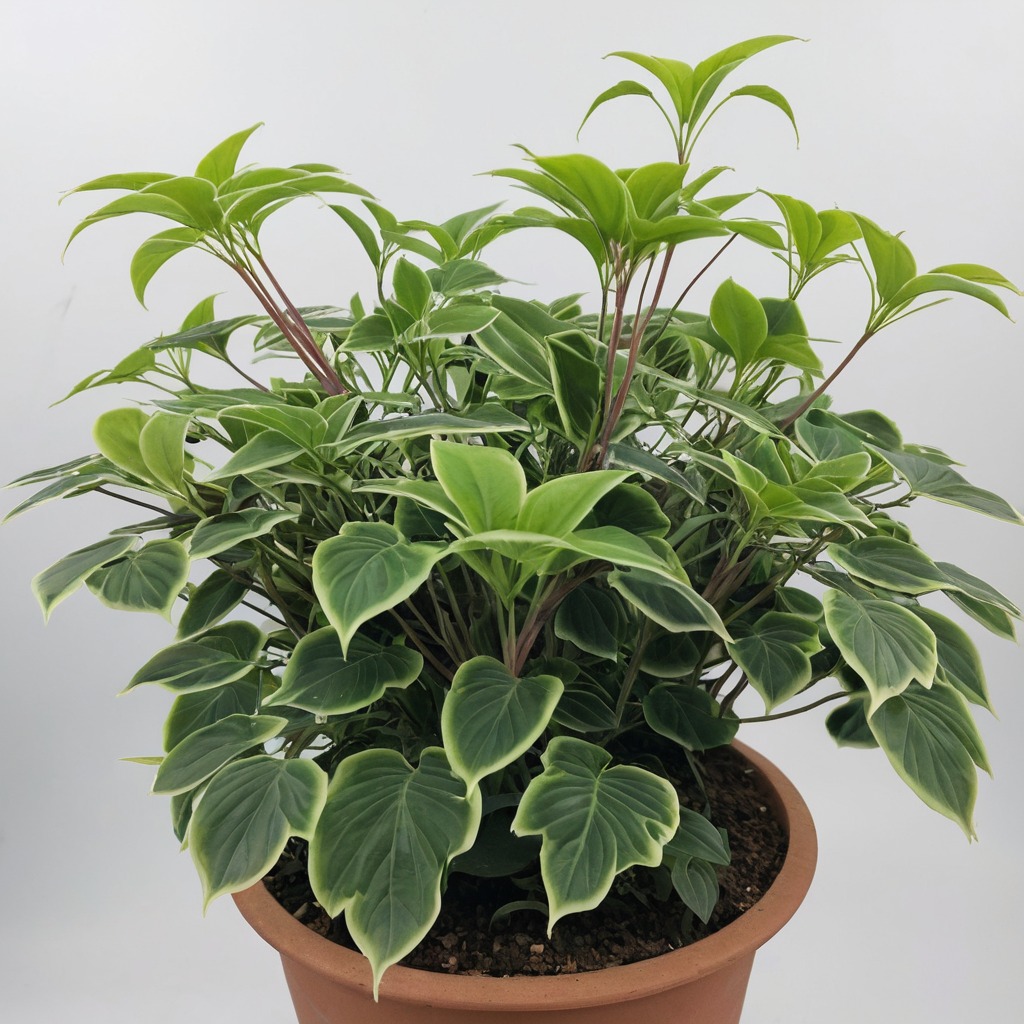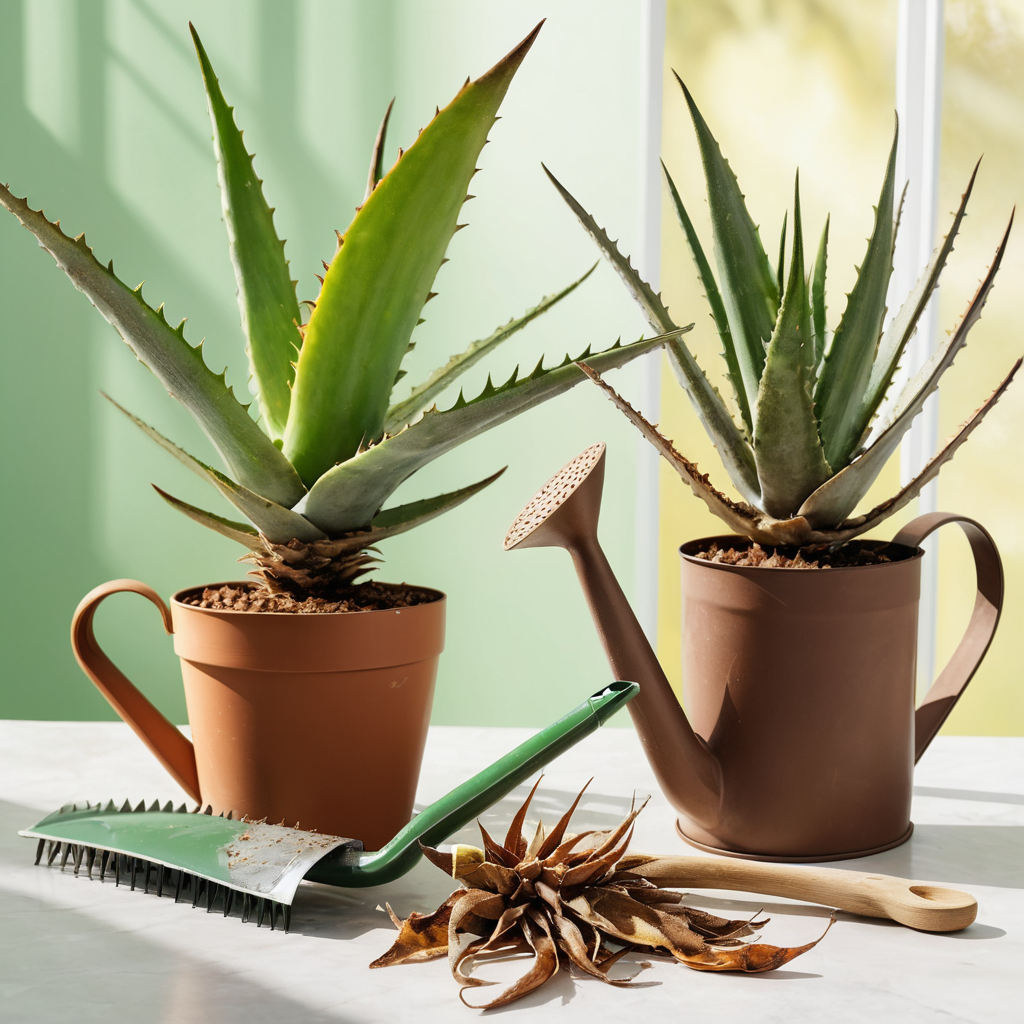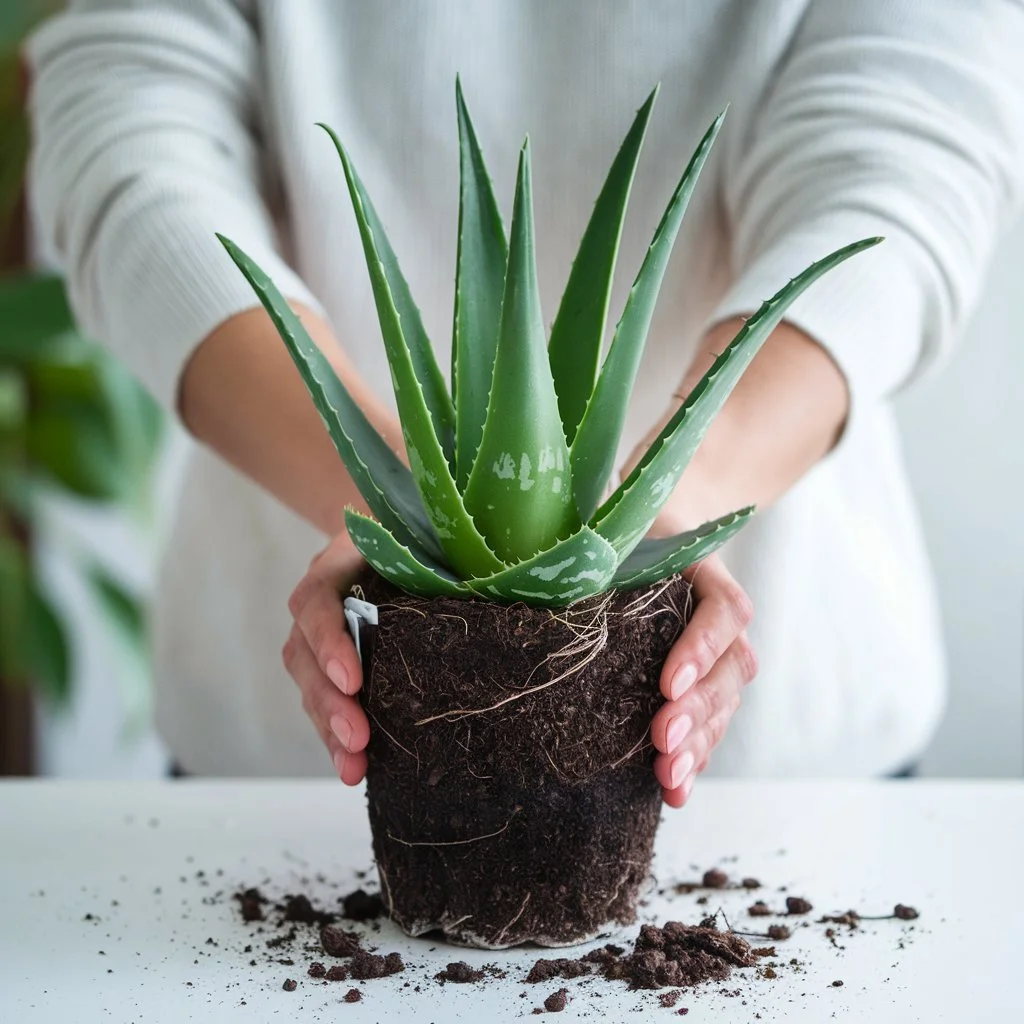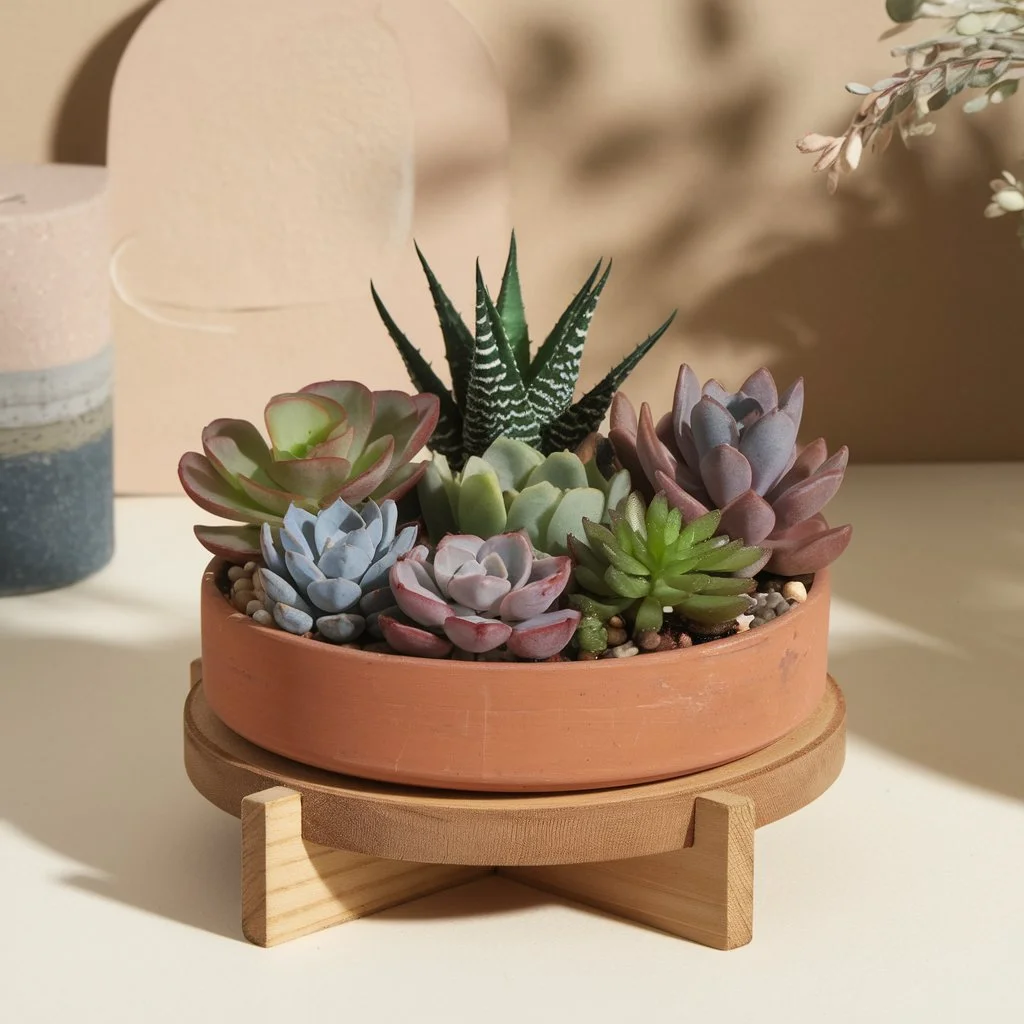What Is the Umbrella Plant?
The Umbrella Plant, scientifically known as Schefflera, is a tropical gem that has won hearts around the globe. This versatile plant gets its name from its striking leaf clusters, which resemble the spokes of an umbrella—a natural design that’s both elegant and eye-catching. Native to tropical regions, it’s a resilient and adaptable plant that thrives indoors and outdoors, making it a favorite for homes, offices, and gardens alike.
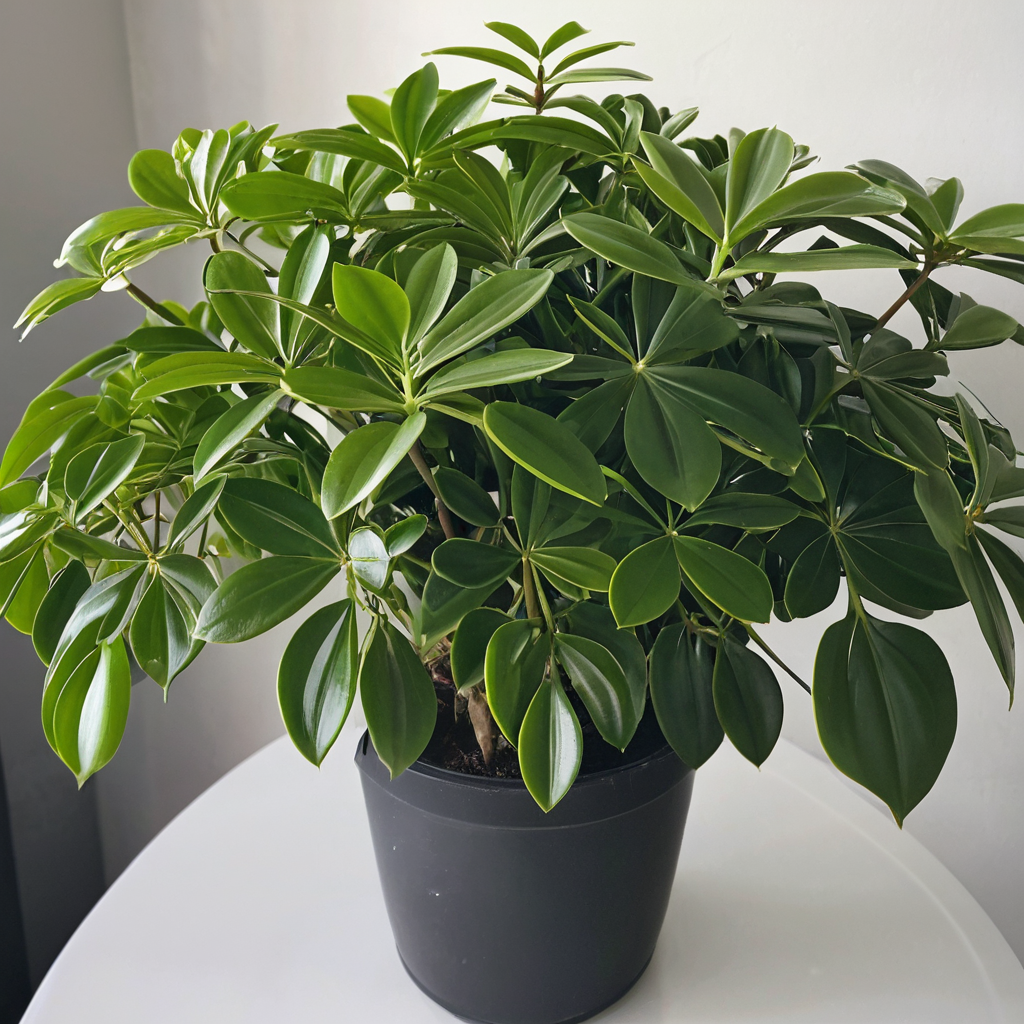
Whether you’re a seasoned plant enthusiast or a beginner looking for a no-fuss option, the Umbrella Plant is a fantastic choice. Its lush foliage adds vibrancy to any setting, and its easygoing nature ensures it remains a joy to care for. But what makes this plant truly special? Let’s explore its unique features and the benefits it brings to your space.
Features and Benefits
The Umbrella Plant isn’t just a pretty face—it’s a hardworking and multi-functional addition to any plant collection. Here’s what makes it stand out:
-
- Aesthetic Appeal
Its glossy, hand-shaped leaves spread out in a dramatic umbrella-like formation, creating a striking visual impact. Whether you choose a compact version or a towering variety, the Umbrella Plant adds a sense of elegance and tropical charm to any room. - Improved Air Quality
Did you know this plant doubles as a natural air purifier? Like a green superhero, it absorbs toxins from the air, helping to reduce indoor pollution and improve overall air quality. Breathing easier has never looked so good!
- Aesthetic Appeal
- Size and Growth Options
-
- Want a small tabletop plant? The Dwarf Umbrella Plant is your perfect match.
- Looking for a larger statement piece? The taller varieties can grow several feet high, making them ideal for filling empty corners or acting as a natural room divider.
Whatever your space, there’s an Umbrella Plant to fit.
- Beginner-Friendly Nature
If you’re new to the world of houseplants, the Umbrella Plant is a dream come true. It tolerates a range of conditions, doesn’t demand constant attention, and bounces back quickly from minor neglect. Even if you forget to water it now and then, it’ll forgive you. - Versatile Placement
This plant thrives in various settings, from bright, sunny spots to slightly dimmer corners. It’s like the plant version of your best friend—happy to go with the flow and adjust to your lifestyle.
Popular Types of Schefflera
With so many varieties, the Umbrella Plant offers something for everyone. Let’s dive into some of the most popular types and what makes each one special:
-
- Dwarf Umbrella Tree (Schefflera arboricola)
- This compact variety is perfect for small spaces, such as desktops, shelves, or cozy apartments.
- Its leaves can be solid green or variegated with yellow or cream-colored patterns, adding a touch of brightness to any room.
- Bonus: It’s a favorite for bonsai enthusiasts due to its manageable size and sculptural qualities.
- Schefflera actinophylla (Octopus Tree)
- A large and dramatic variety, often found gracing offices and spacious living areas.
- Its broader leaves and taller growth make it an ideal focal point for rooms that need a bold, natural accent.
- In the wild, it can grow up to 50 feet tall, but indoors, it’s more restrained—typically around 8-10 feet.
- Dwarf Umbrella Tree (Schefflera arboricola)
- Gold Capella
-
-
- This variegated beauty is known for its bright green leaves streaked with golden yellow, which create a sunlit effect even in shaded rooms.
- It’s a stunning choice for those who want a plant that stands out but still maintains the easy care of its cousins.
-
- Amate
-
- If you’re looking for a tropical vibe, the Amate variety is your go-to. Its oversized, glossy leaves create a lush, exotic feel that transforms any space into a green oasis.
- This type is also more tolerant of low-light conditions, making it perfect for darker corners or offices with minimal natural light.
No matter which variety you choose, the Umbrella Plant is sure to elevate your home or office with its lush greenery, versatility, and undeniable charm. It’s not just a plant—it’s a lifestyle upgrade!
How to Care for an Umbrella Plant
Caring for an Umbrella Plant is like maintaining a great friendship—give it some attention, meet its basic needs, and it’ll reward you with lush, thriving vibes. This plant isn’t demanding, but a little know-how goes a long way to ensure it grows healthy and happy. Let’s break down its care into simple, easy-to-follow steps!
Light Needs
Think of the Umbrella Plant as a laid-back sunbather. It loves bright, indirect light but doesn’t want to get sunburned!
- Best Placement: Choose a spot near a window with filtered sunlight. East- or west-facing windows are ideal.
- Avoid Direct Sun: Too much direct sunlight can scorch the leaves, leaving unsightly brown patches.
- Low Light? No Problem!: While it prefers bright conditions, the Umbrella Plant can tolerate lower light levels. Just don’t shove it into a dark corner for too long—it’ll sulk by dropping leaves.
Best Soil for Growth
The Umbrella Plant isn’t fussy about its soil, but it has a soft spot for well-draining mixes.
- Ideal Mix: Use a standard houseplant potting mix with added perlite or sand for better drainage.
- Drainage is Key: Make sure the pot has drainage holes to prevent water from pooling at the bottom, which can lead to root rot.
- pH Preference: It thrives in slightly acidic to neutral soil (pH 6.0–7.0).
Watering Tips
The Umbrella Plant likes a drink but hates being waterlogged. Think of it as a plant with commitment issues—it needs just enough, but not too much.
- Check the Soil: Before watering, poke your finger about an inch into the soil. If it feels dry, it’s time to water. If it’s still damp, wait a bit.
- Watering Schedule: Generally, water it once a week during warmer months and every 2–3 weeks in cooler seasons.
- Drain, Don’t Drown: Always let excess water drain out of the pot. Sitting in water is a recipe for unhappy roots.
- Watch the Signs: Droopy leaves? It might be thirsty. Yellowing leaves? You could be overwatering.
Ideal Temperature and Humidity
The Umbrella Plant is a tropical native, so it likes things warm and a little steamy—basically, it’s living its best life in a mini spa.
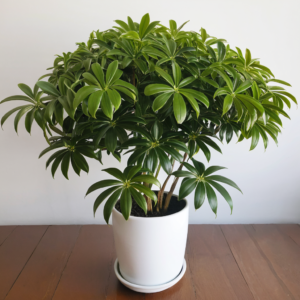
- Temperature Range: Keep it in a space between 60°F and 80°F (16°C–27°C). Avoid exposing it to drafts or sudden temperature changes.
- Humidity Boost: While it’s not super picky, it does appreciate higher humidity levels. If your home is dry, consider:
- Placing a humidifier nearby.
- Grouping it with other plants to create a humidity bubble.
- Giving it a gentle misting with water every few days.
Feeding Your Plant
The Umbrella Plant loves a good meal, but it doesn’t need to eat all the time. Feed it sparingly, and it’ll stay vibrant and lush.
- Fertilizer Type: Use a balanced, water-soluble fertilizer (e.g., 10-10-10 or 20-20-20).
- Feeding Schedule:
- During the growing season (spring and summer), feed it once a month.
- Skip the fertilizer during fall and winter—this plant likes to take a break during the colder months.
- Pro Tip: Always dilute the fertilizer to half the recommended strength to avoid overfeeding, which can damage the roots.
With just a bit of attention to these care essentials, your Umbrella Plant will flourish and become the vibrant, tropical centerpiece of your home. Happy plant parenting! 🌱
Growing and Maintaining Your Umbrella Plant
Growing and maintaining your umbrella plant (Schefflera) is a breeze when you know the basics. With the right techniques, you can keep your schefflera plant healthy, vibrant, and thriving for years. From planting to pruning and preparing it for seasonal changes, here’s everything you need to master umbrella plant care.
How to Plant and Repot
Planting and repotting your umbrella tree plant are crucial steps in ensuring it has room to grow and thrive.
- Planting Basics:
- Start with a well-draining potting mix suitable for houseplants. Adding some perlite or sand can improve drainage, which is key for proper umbrella plant care.
- Choose a pot with drainage holes to prevent waterlogging.
- When to Repot:
- Repot your schefflera plant every 2–3 years or when you notice roots growing out of the pot’s drainage holes.
- Spring is the best time for repotting, as this aligns with the umbrella plant’s active growth phase.
- Repotting Steps:
- Gently remove the schefflera plant from its current pot.
- Loosen the root ball and trim away any dead or rotting roots.
- Place it in a slightly larger pot and fill the gaps with fresh soil.
- Water thoroughly to help the plant settle into its new home.
Repotting not only supports healthy growth but also sets the stage for successful umbrella plant propagation when the time comes.
Simple Pruning Tips
Pruning is essential for shaping your umbrella tree plant, promoting new growth, and maintaining its overall health.
- Why Prune?
- Pruning helps remove dead or yellowing leaves, encourages fuller growth, and keeps your schefflera plant from becoming too leggy.
- When to Prune:
- The best time to prune is during the growing season (spring and summer). Avoid heavy pruning during the plant’s dormant winter phase.
- How to Prune:
- Use clean, sharp pruning shears to avoid damaging the plant.
- Cut just above a leaf node or branch junction to encourage bushier growth.
- Remove any weak, damaged, or crossing branches to improve airflow and sunlight exposure.
Pruning can also provide cuttings for umbrella plant propagation, making it a win-win for you and your plant!
Seasonal Care for Cold Weather
When winter rolls around, your schefflera plant needs a little extra attention to stay healthy and happy. While it’s a tropical plant, it can adapt to cooler climates with the right care.
- Protect from the Cold:
- Keep your umbrella tree plant indoors if outdoor temperatures drop below 50°F (10°C). Sudden exposure to cold drafts can stress the plant and cause leaf drop.
- Place it in a warm spot with bright, indirect light to mimic its natural environment.
- Adjust Watering:
- During winter, your schefflera plant’s growth slows down, so it needs less water. Allow the top inch of soil to dry out before watering. Overwatering can lead to root rot in colder months.
- Humidity Matters:
- The dry indoor air from heating systems can make your umbrella plant unhappy. Combat this by:
- Using a humidifier near the plant.
- Grouping it with other plants to create a humidity-friendly microenvironment.
- Occasionally misting its leaves with water.
- The dry indoor air from heating systems can make your umbrella plant unhappy. Combat this by:
By following these seasonal tips, you’ll ensure your schefflera plant care routine adapts to the changing weather, keeping your umbrella tree plant lush and thriving year-round.
Mastering these steps not only supports healthy growth but also prepares your umbrella plant for successful propagation and a long, happy life in your home. 🌱
How to Propagate an Umbrella Plant
If you’ve ever admired your umbrella plant and thought, I wish I had more of these beauties, you’re in luck! Umbrella plant propagation is a fun and rewarding way to expand your indoor jungle or share the joy of schefflera with friends. Whether you’re working with an umbrella tree plant or its smaller counterparts, propagation is straightforward with the right timing and methods.
Best Time to Propagate
Timing is everything when it comes to umbrella plant propagation. To give your new plants the best chance of success:
- Spring and Summer: These are the ideal seasons for propagating your schefflera plant. During its active growing phase, the plant is better equipped to produce roots and recover from cutting.
- Avoid Dormant Periods: Propagation in fall or winter is less successful since the umbrella plant’s growth slows, making it less likely to root effectively.
By choosing the right season, you’ll set the stage for strong and healthy new schefflera plants.
Propagation Methods
There are two main ways to propagate an umbrella plant: stem cuttings and air layering. Both methods are effective, so pick the one that suits your skill level and resources.
Stem Cuttings
One of the easiest and most popular ways to propagate a schefflera plant.
- What You’ll Need:
- Clean, sharp scissors or pruning shears.
- A small pot with fresh, well-draining soil.
- Optional: Rooting hormone to speed up root development.
- Steps to Follow:
- Choose a healthy stem with at least 4–6 leaves.
- Cut the stem just below a leaf node (the spot where a leaf grows from the stem).
- Remove the bottom leaves, leaving a bare section for rooting.
- Dip the cut end into rooting hormone (optional) and plant it in moist soil.
- Keep the pot in a warm, bright spot with indirect light. Mist the cutting occasionally to maintain humidity.
- Results: Roots should start forming within 2–4 weeks. Once the new plant shows signs of growth, you’ve successfully propagated your umbrella tree plant!
Air Layering
For a more advanced approach, air layering allows you to grow a new schefflera plant without cutting it off until it’s rooted.
- What You’ll Need:
- Sharp knife.
- Sphagnum moss.
- Plastic wrap and twine or tape.
- Steps to Follow:
- Select a healthy stem and make a small cut or remove a thin strip of bark about halfway around the stem.
- Moisten sphagnum moss and wrap it around the cut area.
- Cover the moss with plastic wrap to retain moisture and secure it with twine or tape.
- Check the moss regularly to ensure it stays moist.
- Results: Roots will begin to form within a few weeks. Once the roots are visible through the moss, cut the stem below the new root ball and plant it in fresh soil.
Troubleshooting Propagation Problems
Not all propagation attempts go smoothly. Here’s how to handle common issues:
- Cuttings Not Rooting:
- Ensure the cutting has at least one node buried in soil—this is where roots will grow.
- Keep the soil consistently moist but not soggy.
- Provide bright, indirect light and avoid direct sunlight, which can stress the cutting.
- Leaves Wilting or Dropping:
- High humidity is essential for umbrella plant care during propagation. Mist the cuttings or cover them with a plastic bag to create a mini greenhouse effect.
- Avoid overwatering, which can lead to root rot.
- Rotting Stems:
- Always use sterilized tools to make clean cuts, reducing the risk of introducing bacteria.
- If rot occurs, discard the affected cutting and try again with fresh materials.
Propagation takes patience, but with proper umbrella plant care, you’ll soon have thriving new schefflera plants to enjoy or share. Whether you’re creating more greenery for your space or experimenting with umbrella tree plant propagation for the first time, the rewards are worth the effort! 🌱
Pests and Problems to Watch For
Even the resilient umbrella plant (Schefflera) can run into some hiccups along the way. From unwelcome pests to troublesome leaf issues, staying ahead of potential problems is key to great umbrella plant care. Let’s explore how to spot, prevent, and solve common issues to keep your schefflera plant looking its best.
Common Pests
Your umbrella tree plant might occasionally attract some unwanted visitors, but fear not—they’re manageable with the right approach.
- Spider Mites:
- Tiny, web-spinning pests that suck the sap from leaves, causing a speckled appearance.
- Treatment: Wipe the leaves with a damp cloth and spray the plant with insecticidal soap or neem oil.
- Mealybugs:
- These cotton-like pests gather in leaf joints and feed on plant juices.
- Treatment: Dab them with a cotton swab dipped in rubbing alcohol or spray with neem oil.
- Scale Insects:
- Hard-shelled bugs that attach to stems and leaves, leaving behind sticky residue.
- Treatment: Scrape them off gently with a toothbrush and follow up with insecticidal soap.
Regularly inspecting your schefflera plant for pests is a vital part of umbrella plant care. Catching infestations early makes them much easier to control!
Diseases and How to Treat Them
While diseases are less common than pests, your umbrella plant can occasionally fall prey to fungal or bacterial issues.
- Root Rot:
- Caused by overwatering or poor drainage, this condition leads to mushy, discolored roots and wilting leaves.
- Solution: Remove the plant from its pot, trim affected roots, and replant in fresh, well-draining soil. Cut back on watering.
- Leaf Spot:
- Brown or black spots on leaves may indicate fungal or bacterial infections.
- Solution: Remove affected leaves and improve airflow around the plant. Treat with a fungicide if necessary.
- Powdery Mildew:
- A white, powdery substance on leaves caused by high humidity and poor ventilation.
- Solution: Wipe leaves with a damp cloth, increase airflow, and use a fungicide to prevent recurrence.
Staying vigilant about watering and maintaining a clean environment are essential parts of schefflera plant care to prevent diseases.
Solving Leaf Issues
Your umbrella plant’s leaves are its way of communicating, so pay attention to what they’re telling you!
Dropping Leaves
A common issue that often signals stress.
- Possible Causes:
- Sudden changes in light or temperature.
- Underwatering or overwatering.
- Solutions:
- Move your schefflera plant to a consistent environment with bright, indirect light.
- Check the soil moisture and adjust your watering schedule.
Yellow Leaves
Yellowing leaves can indicate a range of issues.
- Possible Causes:
- Overwatering is the most common culprit.
- Nutrient deficiency or pest infestations.
- Solutions:
- Allow the soil to dry out between waterings.
- Feed your umbrella tree plant with a balanced fertilizer during the growing season.
- Inspect for pests and treat as needed.
Brown Spots
Brown spots on your schefflera plant can be unsightly but are usually fixable.
- Possible Causes:
- Leaf scorch from direct sunlight.
- Fungal infections or poor humidity levels.
- Solutions:
- Relocate your umbrella plant to a spot with filtered light.
- Increase humidity around the plant by misting or using a humidifier.
- Remove affected leaves and treat with fungicide if necessary.
By addressing these pests, diseases, and leaf issues promptly, you’ll ensure your umbrella tree plant thrives in its environment. Keeping an eye on your plant’s needs and maintaining proper umbrella plant care practices will reward you with lush, vibrant foliage year-round. 🌱
Is the Umbrella Plant Right for You?
The umbrella plant (Schefflera) is more than just a pretty face. It’s a versatile, easygoing plant that can fit seamlessly into many lifestyles. But is it the perfect match for you? Let’s explore whether this schefflera plant aligns with your space, routine, and plant parenting style.
Matching Plants to Your Lifestyle
Not all plants are created equal, and the umbrella tree plant is a fantastic choice for plant lovers with varying levels of experience and care routines.
- Frequent Traveler?
-
-
- If you’re often away, the umbrella plant is forgiving of occasional neglect. With proper watering before you leave and a well-lit spot, it can thrive even if you miss a week or two.
- Pair it with a self-watering pot or ask a friend to check in on it to make things even easier.
-
- Small Apartment Dweller?
-
-
- Schefflera plants come in various sizes, so whether you want a tall, statement-making umbrella tree plant or a compact desk companion, there’s an option for you.
- It adapts well to low-light conditions, making it perfect for apartments without abundant sunlight.
-
- Pet Owners
-
- Keep in mind that the umbrella plant is toxic if ingested by cats or dogs. If you have curious pets, place your schefflera plant on a high shelf or in a room they can’t access.
Low-Maintenance Varieties for Beginners
New to plant parenting? Don’t worry—the umbrella plant has your back. Certain schefflera varieties are especially low-maintenance, making them ideal for beginners.
- Dwarf Umbrella Plant (Schefflera arboricola):
-
-
- This smaller cousin of the umbrella tree plant is a popular choice for new plant owners. It’s hardy, adaptable, and thrives with minimal effort.
- Perfect for desks, shelves, or smaller spaces where a full-sized schefflera might not fit.
-
- Variegated Schefflera:
-
-
- Known for its striking green and yellow leaves, this variety adds a pop of color to your home while being just as easy to care for.
- It’s a great way to add visual interest without increasing your workload.
-
- Umbrella Tree (Schefflera actinophylla):
-
- If you’re ready for a slightly bigger challenge, the full-sized umbrella tree plant makes a bold statement in any room. It’s still relatively low-maintenance but thrives with consistent care.
With its adaptability and forgiving nature, the umbrella plant is a fantastic addition to any home. Whether you’re a seasoned green thumb or just starting your plant journey, there’s a schefflera plant that’s perfect for you. 🌱
FAQ
Do umbrella plants thrive in sunlight or low light?
Umbrella plants prefer bright, indirect sunlight but can adapt to lower light conditions. However, too much direct sunlight can scorch their leaves. In lower light, growth may slow, but the plant will still survive.
What’s the best way to take care of an umbrella plant?
To care for an umbrella plant, provide well-draining soil, moderate watering, and a temperature range of 60–75°F (15–24°C). Ensure it gets bright, indirect light and feed it with a balanced fertilizer during the growing season. Regularly inspect for pests and adjust care as needed.
What’s the ideal location for an umbrella plant in your home?
Place your umbrella plant in a spot with bright, indirect light, such as near a window with sheer curtains. It can tolerate some lower light but may grow slower. Avoid placing it in direct sunlight or dark corners to keep it healthy.
What advantages do umbrella plants offer?
Umbrella plants are low-maintenance, making them a great option for busy plant owners. They are also visually appealing with their glossy, vibrant leaves and add a tropical touch to any space. Additionally, they can purify indoor air by removing toxins.
Is it safe to move your umbrella plant outside during the summer?
Yes, you can move your umbrella plant outside during the summer, but ensure it’s placed in a shaded area away from direct sunlight. Gradually acclimate the plant to outdoor conditions to avoid stress. Bring it indoors once the weather turns cooler to protect it from frost.
How can you tell if your umbrella plant is overwatered?
Signs of an overwatered umbrella plant include yellowing leaves, wilting, and root rot. The soil may be consistently soggy, and the plant may develop a musty smell. Allow the soil to dry out before watering again and consider repotting if root rot has occurred.
Is misting beneficial for your umbrella plant?
Misting can help maintain humidity levels around the plant, especially in dry indoor environments. However, umbrella plants typically do not require frequent misting. If the air is too dry, using a humidifier is a more effective solution.
Why is your umbrella plant losing its leaves?
Leaf drop can be caused by stress factors such as changes in temperature, overwatering, or insufficient light. It may also occur if the plant is exposed to drafts or sudden environmental changes. Regular care and stable conditions can help prevent leaf loss.
Are umbrella plants harmful to dogs?
Yes, umbrella plants are toxic to dogs if ingested. They contain compounds that can cause gastrointestinal distress and other symptoms. Keep the plant out of reach of pets or choose a pet-friendly plant if you have animals in the house.
Do umbrella plants help improve indoor air quality?
Yes, umbrella plants can help improve indoor air quality by filtering out harmful toxins like formaldehyde and benzene. Their large, glossy leaves absorb pollutants and release oxygen, contributing to a healthier living environment.
Conclusion
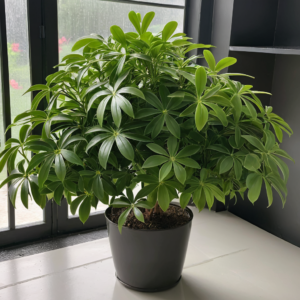 In conclusion, the umbrella plant (Schefflera) is a beautiful and low-maintenance addition to any home. With its adaptable nature, it thrives in a variety of lighting conditions and can purify your indoor air, making it a perfect choice for plant lovers of all experience levels. Whether you’re looking to add a touch of greenery to your space, enjoy the benefits of easy care, or simply appreciate its striking foliage, the umbrella plant is a rewarding choice. By following simple care tips and addressing any potential issues, you’ll enjoy a healthy, vibrant plant for years to come. Happy planting! 🌱
In conclusion, the umbrella plant (Schefflera) is a beautiful and low-maintenance addition to any home. With its adaptable nature, it thrives in a variety of lighting conditions and can purify your indoor air, making it a perfect choice for plant lovers of all experience levels. Whether you’re looking to add a touch of greenery to your space, enjoy the benefits of easy care, or simply appreciate its striking foliage, the umbrella plant is a rewarding choice. By following simple care tips and addressing any potential issues, you’ll enjoy a healthy, vibrant plant for years to come. Happy planting! 🌱
Check out our latest article for more insights, and follow us on Facebook for updates! and connect with us on Instagram, Pinterest, and YouTube for more inspiration!

